NASA’s Artemis I mission just beat a 52-year-old spaceflight record
The NASA Artemis I mission is halfway done. Soon, it will try to photograph Apollo landing sites.

A few hours ago, the Orion capsule of NASA’s Artemis I mission sailed to its maximum distance from Earth.
It took thirteen days for the spacecraft to make this benchmark: 270,000 miles from the planet off which it launched on November 16. It is now poised to enter the second half of its mission, and in another thirteen days, it will enter Earth’s atmosphere faster and hotter than any other human-grade spacecraft ever has.
“We are just super proud of Orion,” Vanessa Wyche, Director of the Johnson Space Center Director, said during a media conference that began at 5:00 p.m. Eastern on Monday, about an hour after the milestone.
The Artemis I Orion capsule took this footage on flight day 13 (Monday, November 28) at 11:34 a.m. Eastern. Here, the Moon almost completely obstructs the spacecraft’s view of Earth.
NASA cited the mission’s excellent performance as reason to give Artemis I seven additional objectives. Mike Sarafin, Artemis I mission manager, said NASA will be stepping back and seeing where it can be smarter and “buy down risk” for the next crewed flight. Sarafin said these new objectives will “further characterize the thermal environment but also the propulsion system” to help make the next crewed flight a success.
“Up to this mission, everything was just test data,” Rick Labrode, Artemis I flight director, said on Monday. “Well, with this effort we’re doing to get real-time performance data [that] will update the models to know exactly how this vehicle is going to operate.”
No astronauts fly on Artemis I, a systems demonstration mission. In the spacefarers’ place are two mannequin torsos from the European Space Agency, and one full NASA mannequin in a spacesuit. But that will change on Artemis II and beyond. The data Orion gathers from its deep space location will tell NASA how to adapt its future missions to radiation and orbital conditions the capsule experiences now.
On Flight day 6 (Monday, November 21) Orion approached the Moon for the outbound powered flyby. This maneuver sent Orion just 81 miles above the lunar surface. Apollo landing sites were in the dark during the pass, but NASA thinks Orion’s camera might view four Apollo sites in its upcoming final lunar flyby.
The NASA mannequin — called Commander Moonikin Campos — bears the surname of spaceflight hero Arturo Campos. He was the electrical power subsystem manager for the Apollo 13 lunar module, who reconstructed his contingency plan to save the Apollo 13 crew and give them enough power to return home safely in 1970.
Howard Hu, Orion Program manager, said the mannequin is in an Orion seat that will be reused. “We will be using that seat for Artemis II,” Hu said on Monday.
On Saturday, November 26, Orion beat the record set by Apollo 13 in 1970 for the farthest distance from Earth traveled by a human-rated spacecraft. This notable milestone took place a day after Orion finally entered the stable, fuel-efficient path around the Moon called the distant retrograde orbit (DRO).
What’s next — In a few days, Orion will swing close to the Moon once more. NASA officials think the spacecraft’s cameras might photograph the sites of four Apollo moon landings.
“Artemis is paving the way to live and work in deep space, in a hostile environment… to ultimately go on with humans to Mars,” NASA administrator Bill Nelson said during Monday’s introduction.
NASA will not announce an Artemis II timeline until Artemis I is complete, Sarafin said.